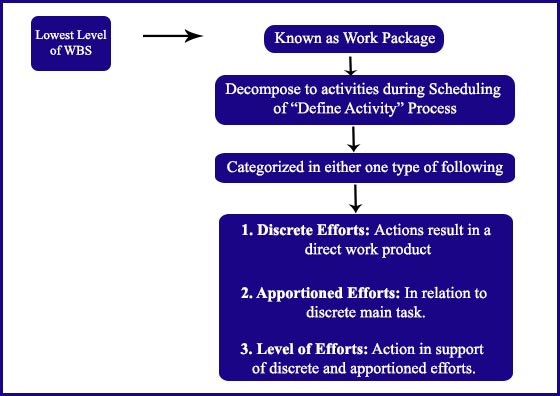

Let’s first begin with the initial understanding of Discrete, Level of Efforts and Apportioned Efforts; these are differentiations of activities which are the result of decomposition of work packages.
According to PMBOK® Guide work package decomposition result in activities that need to be scheduled. Work packages define the project and product deliverables and activities are the actions to complete those deliverables.
So planned work is contained in the lower level of WBS known as Work package and during scheduling, these work packages are further decomposed to activities.

These activities are categorized in one of the following:
As per the PMBOK® Guide defines Discrete, Level of Efforts and Apportioned Efforts as:
These are three earned value management types of activities used to measure work performance.
In order to further explain:
Discrete efforts are actions that directly result in product, service or result or components of a product, service or result.
Example of discrete may include, but not limited to Working Software, Delivered Machines etc.
Apportioned Efforts hold direct supportive relationship to a discrete activity and can be measured in direct proportionate to a discrete effort. Due to the direct proportion relationship with discrete activity, apportioned efforts may not readily divisible from work packages.
Example of Apportioned Efforts may include, but not limited to: testing, inspection, verification, validation activities. These activities are performed in direct proportion to their associated main tasks.
Level of efforts includes project management activities which mainly involve those kinds of activities which are needed to support the discrete and associated apportioned activities. The duration of these activities depends on the duration of the discrete and apportioned activities to which LoE supports.
Example of Level of Efforts may include, but not limited to: Daily stand up, release planning, and retrospective meeting in agile software development, project budget accounting, customer liaison, or oiling machinery during manufacturing, etc. Level of efforts mainly involves collaboration and coordination activities and these activities are repetitive in nature.

Discrete, Level of Efforts and Apportioned Efforts and performance measurement with EVM:
During scheduling of the project, activities are identified using “Define Activities” process, during this process activities are categorized in one of activity type i.e. DE, AE or LOE.
1.) EVM for Discrete Efforts:
Value of discrete efforts is planned and measured using the EVM system. Value is earned by realizing the planned work so earns value of discrete efforts is credited when progress is demonstrated for the planned work.
2.) EVM for Apportioned Efforts: The basic objective of any project is to capture the product vision and that is the reason, EVM of apportioned, and level of efforts need to be considered in context of discrete efforts.
For the apportioned efforts, based on their nature of a proportional relation with discrete efforts, sometime we estimate these efforts in proportion to discrete efforts, for example, 10% of the budgeted discrete efforts may be allotted to the Apportioned Efforts. This is the reason apportioned earned value would automatically be assessed based upon the % work complete for the discrete task.
We can easily the above concept, for example, more code we have more tests we need to develop in order to verify them, if 10% of discrete work has been performed then we need to execute tests only for 10% of the work.
3.) EVM for Level of Efforts: The overall efforts involved in level of efforts depend on discrete and apportioned efforts to which level of effort supports.
As these activities are measured by the passage of time, so normally for these kinds of activities BCWP (Budgeted Cost of Work Performed) and BCWS (Budgeted Cost of Work Schedule) are equal.
So for these activities, there are no schedule variances and cost variances are measured as work progresses. For example subject matter experts are added in release planning and their inclusion was not planned earlier. We estimated 4 hours for release planning and it had performed within 4 hours but cost of performing this activity gets increased.
We need to be careful for the earn value of the Level of Efforts, if these activities are planned, but not executed with resources and their involvement is the basis of cost estimates, this may result misleading cost variants
I would like to mention about how I do manage, this situation in a practical scenario, after every iteration, we review release plan and activities which are not performed controlled through formal baseline changes.
LOE and Critical Path:
LOE may or may not be included in the sequencing of activities; this decision is taken based on standard company procedures.
LOE should not influence the critical path as these activities never add time to the project and repetitive in nature. These activities are included in the EVM system to maintain the consistency with the cost of the project, so care should be taken that inclusion of these activities should not result in invalid critical path.
This situation can be avoided by interdependencies with discrete tasks and by the fact that these activities normally have SS and FF relationship with successor driving discrete activities.
In conclusion, we need to define activities with clear differentiation in Discrete, Level of Efforts and Apportioned Efforts activities in order to avoid distorted earn value or performance measurements. In addition LOE activities should be kept at a minimum to avoid deformed EVM measurements.
I hope this blog has sufficiently answered your all queries related to what is Discrete, Level of Efforts and Apportioned Efforts. Good Luck for your PMP® Certification Exam.
You can join the discussion on the same in our Forum. You can also log into our YouTube channel watch the video on the same
Enroll to our FREE PMP® Introductory Program to learn more about PMP® certification
Introduction to Discrete, Level of Efforts and Apportioned Efforts
| Name | Date | Place | – |
| PMP Certification and Training | 17 July – 15 Aug 2025 | Bangalore | More Details |